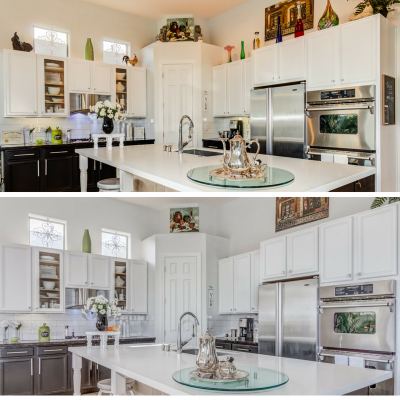How to Sell Your House When It’s Jam-Packed with Junk, Part V…Hide whatever stuff remains: Good idea or bad idea?

Now hiding stuff may seem like your best option, right? You just sweep the dirt under the rug and move your stuff in the garage. Easy.
But that theory may also backfire. According to Galindo, the places you might hide all your junk —the garage, the basement, the closets —are often the areas you want to feature in your home.
Buyers love storage and they love garages. They want to see the entire space they can potentially fill with their own junk. That means you will likely want to feature those areas in photos and on showings. That also means you don’t want to jam pack those areas with boxes.
However, Galindo says, “Junk in your garage is always better than junk in your living room.”
Tips for hiding items in your house full of stuff:
1. You can’t assume buyers won’t look “there.”
Don’t just stick stuff in nooks and crannies where you think buyers won’t look. That doesn’t tend to work, as buyers will be eyeing your closets, pantries, built-ins, medicine cabinets, refrigerator and storage areas.
Before you start looking for hiding places, go through your stuff and get rid of the things you don’t use and don’t cherish. Follow Marie Kondo on Twitter, and read The Life Changing Magic of Tidying Up for inspiration.
Then, follow these practical tips for how to organize key spaces like closets where buyers are sure to peek in—namely, give every space a deep cleaning, cut clutter in half, and stage it like a gorgeous display.
2. Show the garage as a clean, organized space for storage, with plenty of room for the cars.
The purpose of the garage is storage, sure. But clutter in the garage can also get a little out of hand. A quarter of Americans who have two-car garages can’t fit their cars in them; nearly a third can fit just one car in those two-car garages. Make sure your stuff looks organized and neat. Instead of piling stuff on the ground, try these steel industrial shelves from Husky, which hold up to 1,500 pounds. Fill the shelves with stackable, open bins for easy access to tools, equipment and other odds and ends. Ensure that visitors can see the space in its entirety. If it’s a two car garage, let them see the space where two cars can fit.
3. Make sure everything has a place.
Put big bulky things, like your barely used crockpot or sewing machine, in the top back of shelves, and find homes for little tiny but oft-used doodads. If you have an ample amount of small objects, consider buying a craft storage cabinet like this one on Amazon. Only have often-used appliances out on countertops (put the rest in cabinets). Have coats and seasonably inappropriate clothing and gear in closets or storage.
4. Clear priority spaces to keep key rooms looking open and spacious.
Friel encourages clients to clear the spaces that are most visible, like kitchen and bathroom countertops. These are the areas that buyers tend to prioritize, because bathrooms and kitchens are the most frequented rooms in the house. So put your toothbrushes and toothpaste, hair accessories and products, makeup, lotion and medications in your medicine cabinet or drawers.
Hide the toilet paper or put it in a decorative wire basket. If your Kleenex box is in good shape, leave it out. Here are many more tips on staging your bathroom. As for the kitchen, clear away chargers and any non-kitchen items.
Be ruthless even with the appliances and functional products you use everyday. That includes, but is not limited to, any food items, your blender or juicer, your toaster and coffee maker, the knife block, the banana hammock or produce basket, and even the magnets on your refrigerator. Find temporary homes for these items in shelves or cupboards that are easy to access.
No matter what, don’t get overwhelmed. Stay focused. Tackle room by room,
space by space, drawer by drawer and closet by closet. Make the tough decisions: Keep what you love and use; everything else can go. When it gets tough, think about it from a financial perspective.
“It’s expensive. Real estate is expensive,” Friel says. “And there is cost to the clutter of stuff taking up space in a room.”
Also, think about it from the perspective of a potential buyer. Would someone else want to live here?
“When we are listing and selling a home, we position it in a way that helps others see themselves there,” Galindo says.
It’s going to be a big task, but it’ll pay off. Once your home is decluttered and tidied up and all your stuff is donated, sold and stored, buyers can conjure a vision of life in your home. That’s also when they can envision making an offer over asking.
See more at……https://www.homelight.com/blog/how-to-sell-a-house-full-of-stuff/
P.C. Declutter+Blog.com